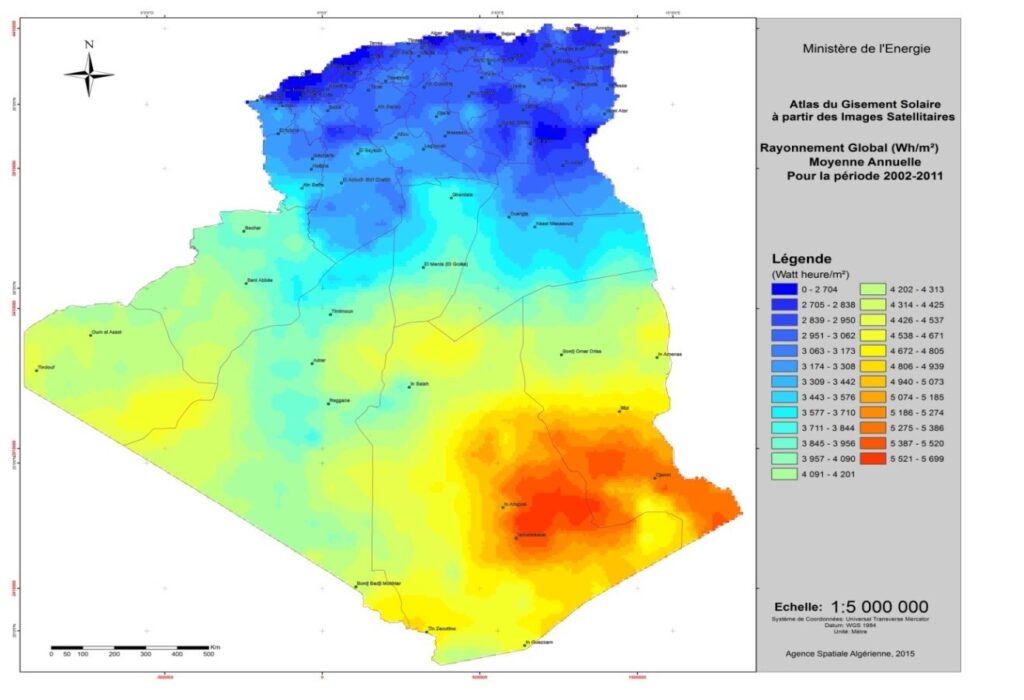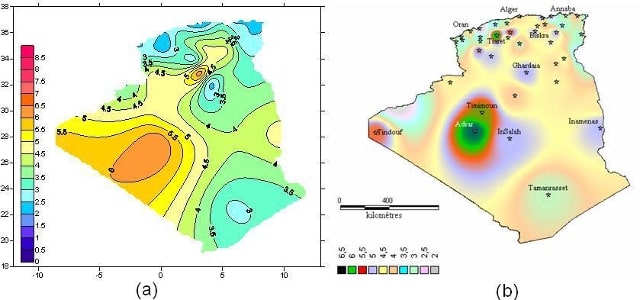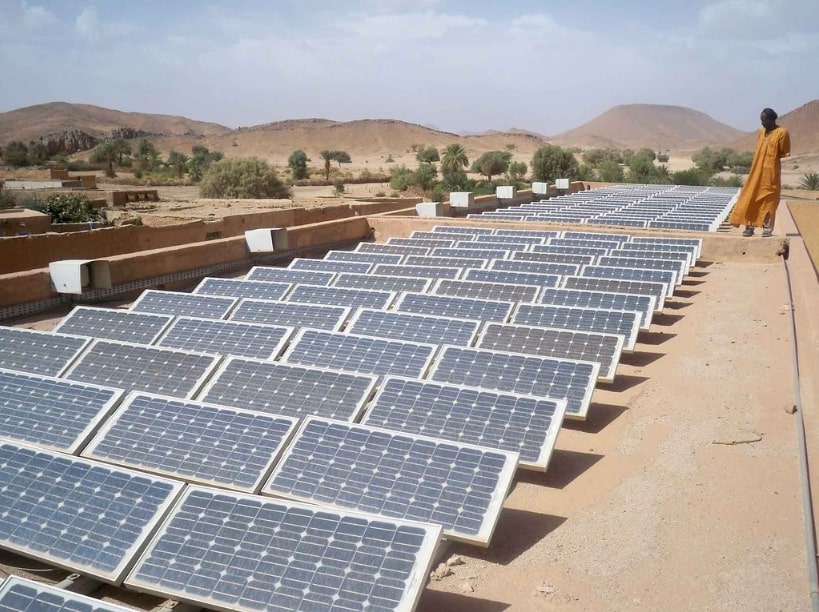 By Salah Bounouh
By Salah Bounouh
Overview
Algeria heavily depends on natural gas and oil to meet its energy needs and exports mainly to Europe. However, the country also has significant renewable energy potential, particularly in solar and wind energy. Algeria is committed to advancing renewable energy and seeks to reach 15,000 MW of power generation capacity based on renewable resources by 2035 in order to meet rising demand for energy and maximize cost-effectiveness.
Algeria Has Significant Renewable Resource Potential
Algeria is the largest country in Africa. Its 2,381,740 square kilometers of land that can be divided into three main geographical zones: the northern part that borders the Mediterranean Sea, the high plains (a semi-arid zone), and the Sahara Desert, which covers 80 percent of its surface and contains major fossil energy sources. Algeria depends heavily on natural gas and oil to meet its own energy and generates foreign exchange by exporting them mainly to Europe.
Besides its vast fossil fuel resources, Algeria has a significant renewable energy potential, particularly in solar and wind energy. Today, the country is committed to the development of renewables and is prepared to exploit these resources and take on the challenge of a successful energy transition. Between solar, wind, geothermal, and biomass, Algeria clearly has several options to diversify its energy mix and ensure energy security.
Solar
To provide sustainable solutions to the country’s dependence on hydrocarbons, solar energy is the main option. Algeria has one of the highest solar potential in the world, with about 2.000 to 3.900 hours of sunshine per year and a daily irradiation of 3,000 to 6,000 Wh/m2.
Algeria’s potential for solar energy is estimated at around 1,700 kWh/m2 of solar energy per year. Investing in solar energy is a necessity for Algeria, which plans to install 15,000 megawatts (MW) of photovoltaic solar energy by 2035.

Concentrated thermodynamic solar energy can also play a significant role and 2,000 MW are planned to be built by 2030. Many wilayas (Algerian states) are suitable, meteorologically speaking, to be the focus of these installations. Sonatrach, the state-owned oil and gas company, plans to install 1.3 gigawatts (GW) of solar capacity country-wide mainly to cover electricity needs.
Wind
The wind resource varies from region to region. The different maps established by the Algerian research center (CDER) show several regions (mainly located in the south of the national territory, such as Adrar, Tamanrasset, Djanet, and Salah) where the high winds are found.

Adrar has had 10 MW of wind capacity installed since 2014. In order to achieve their wind energy goals between 2016 and 2030, a branch of Sonelgaz, the state gas and power firm, had plans to conduct studies to identify suitable locations for wind power in 21 designated areas throughout the country. However, the production of electricity from the wind source has equaled only 0.01%.
Biomass and Geothermal
The energy derived from biomass (from the combustion of organic waste) is also exploited but on a small scale. Between biochemistry and thermochemistry, Algeria intends to push the development of energy from waste by generating 1,000 MW by 2030.
Thermal springs provide heat for greenhouses and buildings including hotels and traditional bathhouses (known as Hammans). Over 240 hot springs have been documented in the northern part of the country, with approximately one third of them having temperatures exceeding 45°C.
Geothermal energy also has the potential to be utilized for electricity generation. Notably, in Biskra, there exist high temperature hot springs that can reach up to 118°C. The installation of 15 MW is scheduled for the next decade.
Plans and Conclusion
While the availability of oil and gas in Algeria currently substantial, the demand for energy continues to increase and non-renewable resources, according to several scenarios, may start to run out in the near future.
To face this possible scenario, which is both rather pessimistic but can be real, opting for the energy transition is not a solution but an obligation that must be undertaken. In order to optimize the cost-effectiveness of solutions for a renewable future, the transition of the energy system requires the integration of all energy sectors.
Taking a new trajectory by developing alternative and renewable energy is key for Algeria. The North African country aims to reach 15,000 MW of electricity generation capacity based on renewable resources by 2035, with a growth rate of 1,000 MW/year.
The renewable energy division of Algeria’s state gas and power firm, Sonelgaz, is in charge of the country’s most recent effort to build a sizable solar PV project, with plans to deploy 2 GW of capacity at locations in the Sahara and High Plains to kick off the 15 GW program.
Salah Bounouh is currently serving as an intern at Sonatrach, the Algerian state-owned gas and oil company. Besides, he is also a web content writer for Algérie360, a news website where he relates engaging and informative content to readers. His passion for energy and sustainability has driven him to create engaging content that educates and inspires others to take action. Salah holds a Bachelor’s Degree in Energy and is currently pursuing a Master’s Degree in Renewable Energy at the University of Sciences and Technology Houari Boumediene (USTHB) in Algiers, Algeria.
Feature Photo Credit: Photo: Magharebia via Flickr Link : https://www.flickr.com/photos/magharebia/5263617050/in/photostream/
Sources:
- Énergie en Algérie [Energy in Algeria]. In Wikipedia, The Free Encyclopedia. Retrieved April 5, 2023, from https://fr.wikipedia.org/wiki/%C3%89nergie_en_Alg%C3%A9rie
- Fekraoui & A. Abouriche Khelifi. Ressources Géothermiques du Nord de l’Algérie – Eléments de l’Atlas Géothermique. Rev. Energ. Ren. : Vaalorisation (1999). Retrieved April 6, 2023, from https://www.cder.dz/download/jnv2_3.pdf
- Geography of Algeria. In Wikipedia, The Free Encyclopedia. Retrieved March 29, 2023, from https://en.wikipedia.org/wiki/Geography_of_Algeria
- Website of The Ministry of Energy and Mines, Government of Algeria. 2023. Accessible here : https://www.energy.gov.dz/?rubrique=energies-nouvelles-renouvelables-et-maitrise-de-lrenergie#:~:text=A%20travers%20ce%20programme%20d,de%202021%2C%20le%20solaire%20thermique.
- Global Wind Energy Council. (2022). GWEC Global Wind Report 2022. Retrieved April 2, 2023, from https://gwec.net/wp-content/uploads/2022/03/GWEC-GLOBAL-WIND-REPORT-2022.pdf
- Centre for Renewable Energy Development (CDER). Carte du gisement éolien en Algérie. Retrieved March 31, 2023, from https://www.cder.dz/spip.php?article1442
- GUERRI, O. L’Energie éolienne en Algérie : Un bref aperçu
- Article on the status geothermal energy from Algeria’s Commissariat for Renewable Energies and Energy Efficiency (CEREFE), Retrieved May 8, 2023.



Leave a Reply